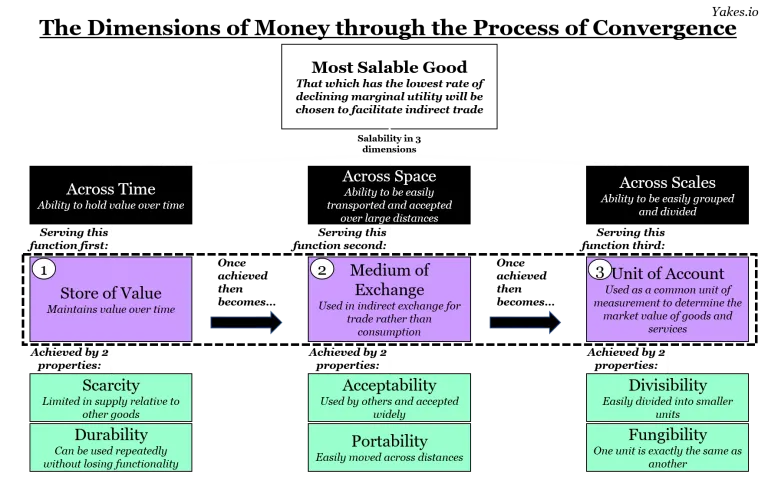What Is Money? Definition and Brief History
Discover the profound essence of money as a social contract, facilitating transactions, embodying purchasing power, and evolving through history. Uncover the responsibilities of money stewards and the quest for a better monetary system.
Money transcends its role as a universally accepted medium of exchange for goods and services, extending beyond a mere helper of transactions and loan repayments. It emerges as a complex social construct that not only streamlines economic interactions but also embodies the essence of time, energy, and purchasing power.
In this exploration, we delve into the multifaceted nature of money, its historical roots, and the responsibilities tied to its administration.
The Evolution of Money: From Barter to Commodity

In the pre-monetary era, societies engaged in barter systems to acquire desired goods and services. However, this method faced inherent challenges, such as the absence of divisibility and transferability. The intricacies of finding counterparts with mutual needs and desires led to inefficiencies in trade.

The limitations of barter became evident as individuals struggled to match their goods with others in a mutually agreeable manner. Even if an exchange occurred, the subjective valuation of goods posed additional hurdles. The absence of a standardized measure hindered seamless transactions.
The introduction of commodities marked a transformative phase in the evolution of money. Commodity, a tradable good serving as a currency, addressed the shortcomings of barter. Gold emerged as a prime example, acting as a commodity with intrinsic value. For centuries, gold backed paper currency, establishing a tangible link between the physical asset and the representation of wealth.
Understanding the Gold Standard

Examining the case of the U.S. Dollar provides insights into the gold standard. Foreign governments could exchange their dollars for a predetermined amount of gold with the U.S. Federal Reserve. Unlike utilitarian items like coffee or milk, gold's value stemmed not from its practical applications but from the collective perception of its beauty and desirability.
Gold, as a commodity, served as a tangible manifestation of wealth based on societal perceptions. This dynamic relationship between money and gold sheds light on the intricate process through which money acquires value—a symbolic representation of inherent worth.
In essence, money transcends its utilitarian function, evolving into a multifaceted concept that intertwines with historical roots, economic dynamics, and the collective consciousness of societal value.
Fiat Money
Another prevalent form of currency, widely embraced by the masses, is fiat money. Unlike its commodity-backed counterparts, fiat money doesn't rely on a tangible asset as a backing; instead, its value is determined by the forces of supply and demand and the collective trust of the people in its intrinsic worth.
🇪🇺@Isabel_Schnabel: Fiat money is not backed by commodities like silver or gold. Its value stems from people accepting it. This is fostered by a credible central bank and the legal tender status, which means people are in principle obliged to accept it at face value. #AskECB https://t.co/Y0SFDBBxXY
— European Central Bank (@ecb) January 10, 2024
The surge of fiat money over the last century can be attributed to the scarcity of gold. Rapidly expanding economies faced challenges in mining sufficient gold to support their growing currency needs. Consequently, a decision was made that tying the value of money to gold was inefficient for thriving economies, given that its true worth was fundamentally rooted in people's perceptions.
Fiat money serves as a symbolic representation of society's collective assessment of value, becoming the cornerstone of why money is brought into existence. In a growing economy, the production of valuable goods and services contributes to the perceived strength of its currency. The symbiotic relationship between economic vitality and currency strength is evident— a robust economy bolsters the value of its currency, while a weakened economy diminishes its perceived value, both domestically through inflation and internationally via currency exchange rates.
A pivotal moment in the history of fiat money occurred in 1971 when the U.S. dollar parted ways with the gold standard. This decision, formalized in 1976, severed the link between the dollar and a fixed gold value. Consequently, the printing of paper money surpassed the available gold reserves, with the dollar's value now intricately tied to the health of the U.S. economy. The disconnect from gold allowed for a more flexible monetary system but also placed increased importance on the economic well-being of the nation.
Today, the value of money, applicable not just to the U.S. dollar but to most currencies, hinges predominantly on its purchasing power, shaped by the forces of inflation. It is crucial to understand that the mere act of printing new money does not create wealth for a country. Instead, the value of money is intricately woven into a perpetual interaction between tangible goods, our desires for them, and the abstract faith we place in their inherent value. Money, in essence, derives its value from our collective desire for it, driven by its ability to facilitate the acquisition of desired products and services.
Defining Money

The definition of money extends beyond its practical utility as a transactional tool. Money, often referred to as a "convenient and beautiful lie," serves as a profound social contract within our communities, streamlining transactions and enhancing overall efficiency.
At its core, money is not just a medium of exchange; it symbolizes the facilitation of transactions, representing a tangible conduit through which individuals trade their time and energy. This reciprocal relationship embodies the essence of contribution – dedicating time at work, and in return, wielding the power of money to access an array of goods and services.
Purchasing Power and Economic Influence
Purchasing power emerges as a distinctive feature, endowing individuals with the authority to redeem money for a diverse range of resources, from essential products to specialized services. This intrinsic dynamic positions money as a driving force that shapes economic landscapes and influences individual livelihoods.
Psycho-technologies, such as coinage and literacy, which have played transformative roles in reshaping cognitive processes. These abstract symbol systems and arithmetic calculations have propelled us from tangible, barter-based transactions to a realm of standardized currency, fostering efficiency in economic calculations.
Fungibility and Evolution
Fungibility emerges as a linchpin, allowing for the comparison of diverse assets and empowering informed choices in transactions. The disruptive advent of Bitcoin, with its fixed supply, challenges traditional notions of inflation, offering advantages over conventional assets like gold.
Stewardship of money transcends transactional duties; it becomes a solemn responsibility critical for preserving the value and integrity of the currency. Neglect or abuse in this role can yield negative consequences at both individual and societal levels.
Money Supply: How Money Is Measured

Money supply, often referred to as M0, M1, M2, and M3, represents the total amount of money within an economy and is categorized based on its liquidity and accessibility. Here's an explanation of each type:
M0 (MB - Monetary Base)
M0, also known as the monetary base or high-powered money, represents the total of physical currency (coins and paper money) in circulation and the reserves held by central banks. It is the most liquid form of money and serves as the foundation for the broader money supply.
M1 (Narrow Money)
M1 includes the most liquid forms of money that are easily accessible for transactions. It consists of:
- Physical currency (coins and paper money) in circulation.
- Demand deposits: Checking accounts and other accounts from which funds can be quickly withdrawn, typically without prior notice.
M2 (Broad Money)
M2 encompasses a broader set of assets compared to M1. It includes all components of M1 and adds other near-money assets that are less liquid but still relatively easily convertible to cash. M2 consists of:
- M1 components.
- Savings accounts: Deposits that earn interest and may have restrictions on withdrawals.
- Time deposits: Fixed-term deposits that earn interest, with penalties for early withdrawal.
- Money market mutual funds: Short-term, highly liquid financial instruments.
M3 (Broadest Money)
M3 is the broadest measure of money supply and includes all components of M2 along with large time deposits, institutional money market funds, and other larger liquid assets. M3 provides the most comprehensive view of the total money supply in an economy.
How Money Is Created

The creation of money within an economy involves a multifaceted process, largely influenced by the actions of the central bank. Money, essentially a representation of perceived value, is not solely confined to physical bills; its generation and manipulation extend beyond mere printing.
In the context of the United States, where the central bank is the Federal Reserve (the Fed), one method employed to increase the money supply is through the purchase of government fixed-income securities in the open market. By acquiring these securities, the central bank infuses money into the marketplace, effectively placing it in the hands of the public. Remarkably, the central bank doesn't need to possess physical currency to undertake this action; it has the authority to create money digitally and transfer it to those selling the securities.
Alternatively, the Fed can influence the money supply by adjusting interest rates. Lowering interest rates allows banks to provide low-cost loans or credit, a phenomenon termed "cheap money." This strategy aims to encourage businesses and individuals to borrow and spend, thereby stimulating economic activity.
Conversely, when the central bank seeks to decrease the money supply, perhaps to combat inflation, it engages in the sale of government securities. In this scenario, the money paid by the buyer is essentially withdrawn from circulation, contributing to a reduction in the overall money supply. It's important to note that this explanation involves generalizations for the sake of simplicity, as the intricacies of monetary policy can be more complex in practice.
Bottom Line
In conclusion, in this guide we saw the multifaceted nature of money, transcending its role as a mere transactional tool. From symbolizing reciprocal contributions to wielding economic influence, understanding money's essence becomes crucial for informed decision-making.
Fungibility, economic evolution, and the responsibilities tied to money stewardship further underscore its profound impact on both individual lives and societal dynamics. This guide serves as a compass, navigating the intricate terrain of money's significance in our interconnected world.

